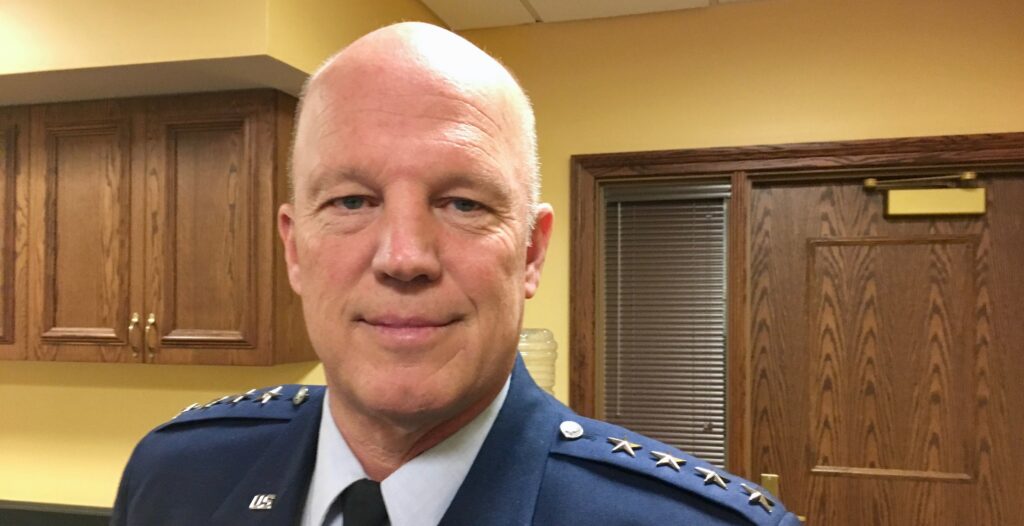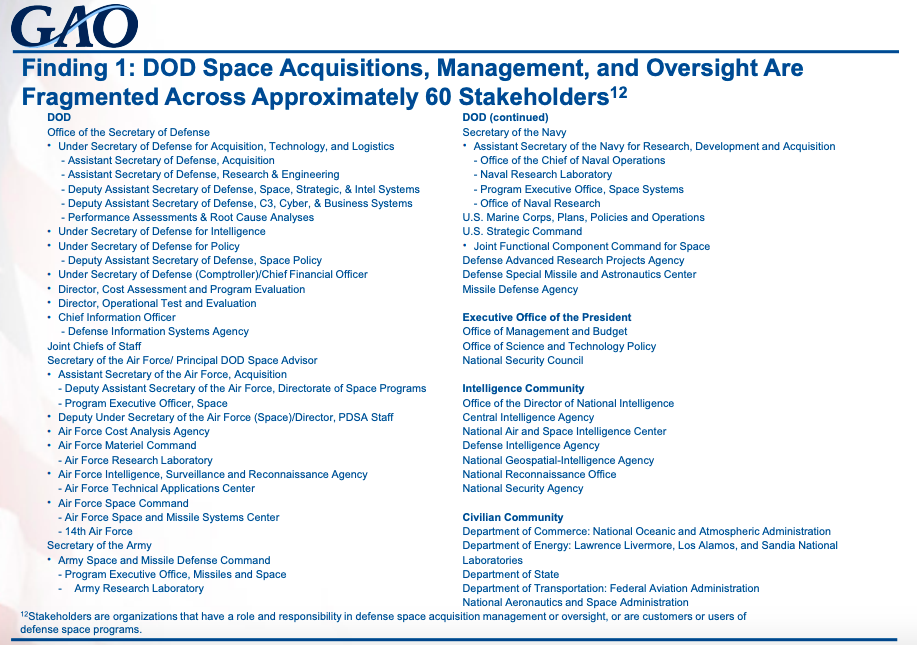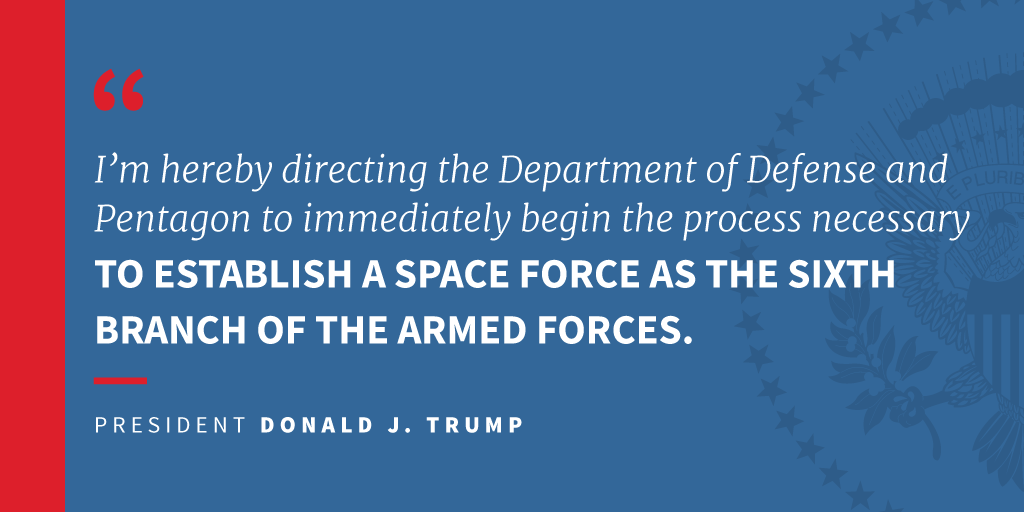Space Force & Beyond: Gen. Raymond’s 3-Ring Space Circus
Posted on

Gen. Jay Raymond, Commander US Space Command, Commander Air Force Space Command and maybe Chief of Staff US Space Force.
UPDATED: The Air Force argues that no, really, there will be only two hats.
WASHINGTON: The newly confirmed Commander of US Space Command, Gen. John Raymond, may face not one, not two, but three Herculean tasks over the next year: standing up SPACECOM as a new Combatant Command; managing the long-standing Air Force Space Command as it moves under the new SPACECOM; and — if the Senate has its way –starting up the new Space Force.
If this sounds both confusing and daunting, that’s because it is.
“It makes no sense to ask a single individual to do all three jobs, especially during the critical first two years,” says Doug Loverro, former deputy assistant secretary of defense for space policy and a long-time proponent of a Space Force. “That is basically setting it up for failure.”
Another former DoD official agreed: “There is concern that Gen. Raymond will be overloaded, especially as his job isn’t to run multiple organizations which would be hard enough, but to create them.”
A retired senior Air Force officer with close ties to all things space was a bit less worried — but he raised a much larger question: What’s the point of all this reorganization if, in the end, the same people will be doing the same jobs, just wearing different badges?
“Triple hatting is a bit much in terms of span of control,” he told me wryly. (Span of control is the longstanding organizational principle that no one manager or commander should have too many subordinates reporting to them directly).
“That said, since the personnel in all three commands are all the same personnel, it can be accomplished, as Jay [Raymond] is a capable and competent leader,” he continued. “However, it begs the question of what are the actual tangible improvements to our operational space architecture that will result?”

(click graphic to expand)
Space Agency Bingo
Because we are talking acronym soup, it’s worth breaking this down:
First, the new SPACECOM was officially established in February by a White House Executive Order, although it’s not yet officially stood up. It shares the name of the old Space Command that started in 1985 — before the Goldwater Nichols Act created the modern system of geographical and functional joint Combatant Commands. In 2002, the original SPACECOM merged into US Strategic Command. Now a new SPACECOM is being created by taking elements out of STRATCOM. But the new version will function very differently.
Reagan-era SPACECOM’s job was to centralize missile warning and space launch operations at a time when only major powers had significant numbers of satellites. Today’s 2.0 version will focus on a new and wider range of threats in a much busier orbital setting, from inadvertent debris that can damage satellites by accident, to missiles that can destroy them on purpose, to cyber and electronic warfare attacks that can cripple the networks that connect them to the users on the ground. As the commander of this functional Combatant Command, Raymond will be responsible for command and control of all space ‘warfighters’ in peacetime and wartime.
So when will the new SPACECOM officially open for business? According to multiple sources, the ribbon cutting will wait until after NASA finishes its planned celebrations of the 50th anniversary of the Apollo 11 Moon landing. The ‘optics’ of celebrating the new warfighting command clash with those of NASA’s peaceful mission in a way that is not politically helpful with the US public or with allies, these sources explain. So the best guesstimate about the timing of the standup is late this summer. One source saying that the paperwork is already prepared for the Secretary of Defense’s signature (or Acting Secretary as the case may be).
The core of the new SPACECOM, which Raymond leads, will be the existing Air Force Space Command, which Raymond also leads. ASFPC is a step below a combatant command: It’s a “major command” under the Air Force, for which it provides satellites, ground control centers, and skilled personnel, and acts as STRATCOM’s Joint Force Space Component (JFSCC), alongside co-equal components for missile defense, air operations (i.e. bombers), and nuclear missile submarines.
Under AFSPC, in turn, is the Space & Missile Systems Center (confusingly, “SMC”) that actually develops and procures space systems. The relationship between AFSPC’s Space & Missile Systems Center and the nascent (and embattled) Space Development Agency, however, is painfully unclear, including to a skeptical Congress.
Air Force Space Command will continue to exist: It’ll keep doing the same missions, just change who it reports to: SPACECOM instead of STRATCOM. (Although in future its leader might be a three-star instead of a four-star, but that is down the road.) So AFSPC ‘warfighters’ who currently report to JFSCC — led by Raymond — will now report to SPACECOM — also led by Raymond — and get new insiginia on their uniforms. (The new logo, I’m told is already designed).
The relatively small Joint Force Space Component Command (JFSCC) element — about 140 Air Force, Navy, Army and Marine Corps troops at Schriever AFB in Colorado — will essentially dissolve into the new SPACECOM.
An Air Force spokesperson explained to me today: “Air Force Space Command will remain in place with its OT&E [organize, train and equip] mission, and all the Operational Wings under AFSPC will continue to execute their critical operational missions that directly support the Joint Force.”
Clear-ish so far? Well, now it really gets complicated.

What About The Space Force?
Enter Space Force. Or at least the Senate version of it included in the fiscal year 2020 National Defense Authorization Act (NDAA). That bill would make the commander of SPACECOM, Gen. Raymond, also the chief of staff of the new Space Force. In practice, the Space Force would take over all the Air Force’s space-related acquisition, sustainment, and personnel functions. Eventually it might also take over space segments of the Army, Navy, and Marines, but not for at least a year.
This version of the Space Force would be a co-equal armed service alongside the Air Force within the Department of the Air Force, just as the Marine Corps is a co-equal service inside the Department of the Navy. As an armed service, not an operational warfighting command, the Space Force’s role would be to “organize, train, and equip” units for use by Space Command, which would run actual operations.
But wait a second. Isn’t providing forces to SPACECOM exactly what Air Force Space Command is supposed to be doing? Why, yes it is!
How that division of labor/bureaucratic overlap/organizational horror show gets resolved is not at all clear. But if Raymond is handed command of Space Force, he will need to build it from the bottom up, starting with Air Force assets and people and perhaps expanding from there as Congress sees fit.
UPDATE: To further muddy the waters, AFSPC is arguing that actuality, there will only be two hats in the ring if the Senate plan goes through. A spokesperson told me this evening that because the Senate would simply redesignate AFSPC as the Space Force: “As such, Raymond would then be dual-hatted as both commander of US Space Command and of the Space Force for one year before the jobs are split. Thus, there is no triple hat recommendation.”
However, according to well-placed space official: “They are being semantic. Sure under JUST the Senate plan, AFSPC and Space Force are the same. But you still have to run AFSPC as you establish the Space Force, so it is still a new job to add to the other already existing jobs. Setting up a new service is more than just changing the signs at the gate. It is establishing personnel policy, new connective tissue to the other space organizations, and rethinking what it means to be a separate force.”
UPDATE ENDED
Of course, we don’t know what is ultimately going to come out of the Senate and House on the establishment of Space Force, which depends on the final language incorporated in the annual National Defense Authorization Act. The full House is expected to vote on the House Armed Services Committee (HASC) version of what it calls a Space Corps — with pretty much the same organizational structure as the Senate but less detailed, and with a different name — sometime in July. Then, we can expect the conference committee to haggle out a compromise between the House and Senate versions of the NDAA.
Of course, the NDAA can only authorize the creation of the Space Force/Corps/Empire. The appropriations committees have to provide actual funds for it. And that funding is up in the air, given that the House committee has snubbed the Trump Administration by appropriating only $15 million for a study of the proposal. The Senate appropriators are more likely to go along with the administration’s request for $72.4 million in startup costs, but even the Republican leadership of the committee have concerns about the potential costs.
So everything is up in the air — or maybe much higher. Watch this space.
Subscribe to our newsletter
Promotions, new products and sales. Directly to your inbox.
